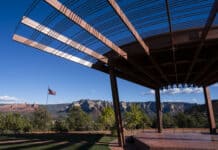On the surface, an Arizona state senator from Chandler and Gilbert may be responsible for raising your sewer fees by 7 percent, should his Senate Bill 1430 pass. The bill would negate Sedona’s ordinance charging sewer fees on vacant parcels not connected to the city’s sewer system.
Sen. Warren Petersen [R-District 12] drafted the bill and the only member of the public to speak is a retired Maricopa County judge who, by sheer coincidence, also owns land in Sedona, which by sheer coincidence, is the only one of Arizona’s 91 municipalities that charges such a fee.
According to Sedona City Code 13.15.100.B, “A capacity standby fee will be charged to property owners of undeveloped property located in an area where the city wastewater system is available for connection.”
The one way to avoid this fee is if the parcel can’t be developed, to wit, “A capacity standby fee will not be charged for vacant parcels that, as determined by the city engineer, are not capable of being developed for reasons such as their size, unique configuration, governmental ownership or zoning designation as open space.”
The background of the capacity standby fee, like the sewer lines themselves, is a far deeper problem.
The city sewer system has been the single largest headache for Sedona to tackle since incorporation in 1988. Building and maintaining the city’s sewer system and connecting homes and businesses has been an arduous, multi-decade process. One former mayor once quipped that tourists fund the city and residents fund the sewer system.
More than half the city is connected to the city sewer system with the other half on septic or using other alternatives with the hope that they one day may connect — much the same way one may anticipate the Rapture or an Arizona Cardinals Super Bowl victory.
Connecting a residential parcel to the city sewer is $9,914.20, which does not cover the construction costs to the home itself, just the connection to the sewer line. Sedona’s hilly landscape also exasperates the difficulties. A flat city like Phoenix or one with a steady slope like Jerome could just build simple lines and roll sewage downhill to the water treatment plant.
Some residents rightly suggested it would have made more sense decades ago to use the 1862 Homestead Act to annex 160 acres of U.S. Forest Service land inside city limits between Soldiers Pass and Uptown and build City Hall and a wastewater treatment plant at the site and use the effluent for a park or community golf course. It is one of the lowest points in the city, located safely away from Oak Creek and surrounded by the property on three sides.
But we didn’t and so the city pumps its wastewater miles downhill, then back uphill to the Wastewater Reclamation Plant five miles outside of town between Sedona Shadows and Forest Road 525 where treated effluent is used to create the Sedona Wetlands Preserve. All that adds to the city’s annual maintenance costs.
Losing the capacity standby fee to these vacant parcels will cost the city about $400,000, which will be shifted to other users — or actual users I should say, because vacant parcels, by definition, have no users.
It can’t really be fair to charge property owners a fee for a service they aren’t using, even if that means the rest of us flushing toilets and using sinks have to pay more for the privilege.



















